Witness Community Highlights

The September 2022 issue of Witness Community Highlights is now available online. This issue includes three articles: Arctic Observing Summit 2022: A Call to Action, a summary of recommendations from the summit; Infrastructure and Permafrost Degradation in Point Lay, Alaska, an overview a multi-disciplinary team’s study of the effects of thawing permafrost on village infrastructure; and ARCUS Member Profile of Gaurav Madan, Doctoral Research Fellow at the University of Oslo.
For questions, or to suggest topics for future articles, please contact Betsy Turner-Bogren, ARCUS (betsy [at] arcus.org).
Arctic Indigenous Scholars Visit Washington, DC 26-30 September
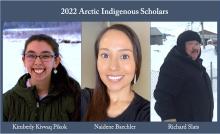
Three Arctic Indigenous Scholars—Naidene Baechler, Kimberly Kivvaq Pikok, and Richard Slats—will spend the week of 26–30 September meeting with a variety of policy- and decision-makers engaged in Arctic issues, including NSF, NOAA, EPA, US Department of Education, Bureau of Indian Education, and Senators Sullivan and Murkowski. The Arctic Indigenous Scholars Program is led by ARCUS and the Inuit Circumpolar Council (ICC) Alaska, and supported by the National Science Foundation's Division of Arctic Sciences and the Smithsonian Institution Arctic Studies Center.
Sea Ice Outlook September Report

The 2022 September Sea Ice Outlook (SIO) Report is now available online. The Sea Ice Outlook, managed by the Sea Ice Prediction Network–Phase 2 (SIPN2) Project Team, provides an open process for those interested in Arctic sea ice to share predictions and ideas. The monthly reports contain a variety of perspectives—from advanced numerical models to qualitative perspectives from citizen scientists. The Outlook is not an operational forecast.
For the 2022 September SIO Report, 22 contributions were received that included pan-Arctic predictions. Of those contributions, seven included predictions for the Alaska region, seven included predictions for pan-Antarctic, and 10 submitted September mean sea-ice extent anomalies. This report includes discussions of the contributed forecasts for the pan-Arctic, Alaska region, and pan-Antarctic; Arctic sea-ice extent anomalies; predictions from spatial fields; and current conditions.
The median September Outlook value for September 2022 pan-Arctic sea-ice extent is 4.90 million square kilometers, which is higher than that from August (4.83 million square kilometers), July (4.64 million square kilometers), and June (4.57 million square kilometers).
For questions, please contact Betsy Turner-Bogren, ARCUS (betsy [at] arcus.org).
Arctic Research Seminar with Charlie Paull

ARCUS invites registration for the next Arctic Research Seminar featuring Charlie Paull, Senior Scientist at the Monterey Bay Aquarium Research Institute (MBARI). Charlie’s presentation, titled “Decomposing Submarine Permafrost in the Canadian Beaufort Sea,” will be held via Zoom on Wednesday, 5 October 2022 at 9:00 a.m. AKDT (1:00 p.m. EDT). Registration is required for this event.
ARCUS 2022 Annual Meeting
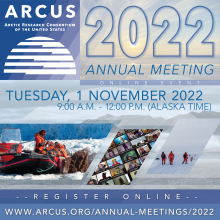
Please join ARCUS for our 2022 Annual Meeting on Tuesday, 1 November 2022 from 9am-12pm AK. This virtual event brings the ARCUS membership community together to share news, exchange ideas, and explore Arctic research and education collaboration opportunities. This is an open event and we encourage anyone who might be interested in learning more about ARCUS and how to get more involved to attend.
Witness Community Highlights

The August 2022 issue of Witness Community Highlights is now available online. This issue includes three articles: Supporting Arctic Food Sovereignty through Sustained, Coordinated Observations of Arctic Change, an overview of the Research Networking Activities for Sustained Coordinated Observations of Arctic Change (Arctic CoObs RNA); Puzzling Vegetation Trends in the Yukon-Kuskokwim Delta are Resolved in 40-year Climate Record, a summary of recent findings that sea-ice concentration drives vegetation trends; and New Project Connects Indigenous Knowledge and Western Science to Better Understand Impacts of Climate Change on Arctic Rivers, highlights of a five-year project guided by an Indigenous Advisory Council with focus on Arctic rivers in Alaska and Canada and the Yukon River drainage.
For questions, or to suggest topics for future articles, please contact Betsy Turner-Bogren, ARCUS (betsy [at] arcus.org).
Call for Sea Ice Outlook Contributions
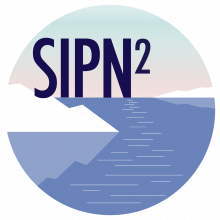
The Sea Ice Prediction Network–Phase 2 (SIPN2) Project Team announces an open Call for Contributions to the 2022 Sea Ice Outlook (SIO) September Report and invites predictions for pan-Arctic, pan-Antarctic, and Alaskan regional September monthly mean sea-ice extent (based on May, June, July, and August data). Submissions for the Alaska region (i.e., Bering, Chukchi, and Beaufort seas) are particularly encouraged. The SIO provides an open process for those interested in Arctic sea-ice to share predictions and ideas. The monthly reports contain a variety of perspectives—from advanced numerical models to qualitative perspectives from citizen scientists. The Outlook is not an operational forecast.
September Submission Deadline: 6:00 p.m. (AKDT) Monday, 12 September 2022 (firm).
Sea Ice Outlook August Report

The 2022 August Sea Ice Outlook (SIO) Report is now available online. The Sea Ice Outlook, managed by the Sea Ice Prediction Network–Phase 2 (SIPN2) Project Team, provides an open process for those interested in Arctic sea ice to share predictions and ideas. The monthly reports contain a variety of perspectives—from advanced numerical models to qualitative perspectives from citizen scientists. The Outlook is not an operational forecast.
For the 2022 August report, 28 contributions were received that included pan-Arctic predictions. Of those contributions, eight included predictions for the Alaska region, nine included predictions for pan-Antarctic, and 12 submitted September mean sea-ice extent anomalies. This report includes discussions of the contributed forecasts for the pan-Arctic, Alaska region, and pan-Antarctic; Arctic sea-ice extent anomalies; predictions from spatial fields; and current condition.
The median August Outlook value for September 2022 pan-Arctic sea-ice extent is 4.83 million square kilometers, which is higher than that from July (4.64 million square kilometers) and June (4.57 million square kilometers).
For questions, please contact Betsy Turner-Bogren, ARCUS (betsy [at] arcus.org).
ARCUS Early Career Conference Funding Award 2022 Call for Applications
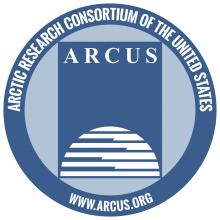
The Arctic Research Consortium of the US (ARCUS) Early Career Conference Funding Award supports US-based, early career researchers and students to participate in meetings and events relevant to Arctic research. Travel awards will cover airfare, lodging, registration fees, session/abstract submission costs, and other relevant expenses related to conference attendance for one conference or event occurring during the period of 15 October 2022 – 1 April 2023. Applications are due by 5:00 p.m., Friday, 16 September 2022.
Arctic Research Seminar with Carolina Behe

ARCUS invites registration for the next Arctic Research Seminar featuring Carolina Behe, the Indigenous Knowledge/Science Advisor for the Inuit Circumpolar Council Alaska (ICC Alaska). Carolina’s presentation, titled “Circumpolar Inuit Protocols for Equitable and Ethical Engagement (EEE): Sharing the EEE Protocols - Publication to Implementation,” will be held via Zoom on Thursday, 18 August 2022 at 9:00 a.m. AKDT (1:00 p.m. EDT). Registration is required for this event.
New Curriculum Unit Available
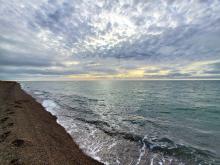
ARCUS is pleased to share a new resource, a curriculum unit focused on the Arctic Ocean. This curriculum unit, funded by the North Pacific Research Board, updates lessons originally created by PolarTREC alumni teachers to create a unit that uses recent data, aligns with NGSS, polar, and ocean literacy principles, and encourages cultural relevancy. The entire unit can be downloaded through the resources section of the PolarTREC website.
Live Event with PolarTREC Teacher Rebecca Siegel
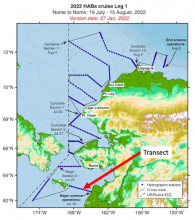
Please join us for a live event with teacher Rebecca Siegel on Thursday, 4 August 2022 at 9:00 AM Alaska (1 PM Eastern) time. She will be presenting while aboard the Norseman II somewhere in northern Arctic waters. Rebecca is assisting on a project focused on Harmful Algal Blooms in Arctic Waters. She will be discussing the research, what it’s like to live on a ship, and introduce us to part of the research team. The event will last for one hour with a Q&A session at the end. Tell your friends, colleagues, and family. This event is free and easy to join!
Call for Sea Ice Outlook Contributions

The Sea Ice Prediction Network–Phase 2 (SIPN2) Project Team announces an open Call for Contributions to the 2022 Sea Ice Outlook (SIO) August Report and invites predictions for pan-Arctic, pan-Antarctic, and Alaskan regional September monthly mean sea-ice extent (based on May, June, and July data). Submissions for the Alaska region (i.e., Bering, Chukchi, and Beaufort seas) are particularly encouraged. The SIO provides an open process for those interested in Arctic sea-ice to share predictions and ideas. The monthly reports contain a variety of perspectives—from advanced numerical models to qualitative perspectives from citizen scientists. The Outlook is not an operational forecast.
August Submission Deadline: 6:00 p.m. (AKDT) Monday, 15 August 2022 (firm).
Sea Ice Outlook July Report
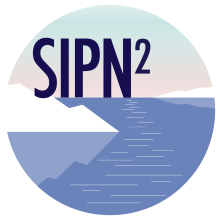
The 2022 July Sea Ice Outlook (SIO) Report is now available online. The Sea Ice Outlook, managed by the Sea Ice Prediction Network–Phase 2 (SIPN2) Project Team, provides an open process for those interested in Arctic sea ice to share predictions and ideas. The monthly reports contain a variety of perspectives—from advanced numerical models to qualitative perspectives from citizen scientists. The Outlook is not an operational forecast.
For the 2022 July report, 30 contributions were received that included pan-Arctic predictions. Of those contributions, eight included predictions for the Alaska region, nine included predictions for pan-Antarctic, and 12 submitted September mean sea-ice extent anomalies. This report includes discussions of the contributed forecasts for the pan-Arctic, Alaska region, and pan-Antarctic; Arctic sea-ice extent anomalies; predictions from spatial fields; and current condition.
The median July Outlook value for September 2022 pan-Arctic sea-ice extent is 4.64 million square kilometers, which is slightly higher than the median cited in the June report of 4.57 million square kilometers.
For questions, please contact Betsy Turner-Bogren, ARCUS (betsy [at] arcus.org).
Witness Community Highlights

The July 2022 issue of Witness Community Highlights is now available online. This issue includes two articles: "Satellite Observations Indicate a Boreal Forest Biome Shift is Underway," a summary of emerging evidence that climate change dynamics could lead to a gradual northward shift of boreal trees and shrubs across the circumboreal forest; and "A Community Level and Strength-Based Approach to Suicide Prevention," an overview of work by the Alaska Native Collaborative Hub for Research on Resilience to change the narrative on suicide prevention and re-imagine Indigenous research partnership within an academic environment.
For questions, or to suggest topics for future articles, please contact Betsy Turner-Bogren, ARCUS (betsy [at] arcus.org).
Call for Sea Ice Outlook Contributions

The Sea Ice Prediction Network–Phase 2 (SIPN2) Project Team announces an open Call for Contributions to the 2022 Sea Ice Outlook (SIO) July Report and invites predictions for pan-Arctic, pan-Antarctic, and Alaskan regional September monthly mean sea-ice extent (based on May and June data). Submissions for the Alaska region (i.e., Bering, Chukchi, and Beaufort seas) are particularly encouraged. The SIO provides an open process for those interested in Arctic sea-ice to share predictions and ideas. The monthly reports contain a variety of perspectives—from advanced numerical models to qualitative perspectives from citizen scientists. The Outlook is not an operational forecast.
July Submission Deadline: 6:00 p.m. (AKDT) Wednesday, 13 July 2022 (firm).
Sea Ice Outlook June Report
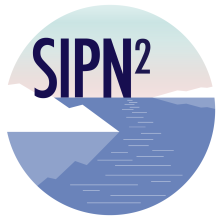
The 2022 June Sea Ice Outlook (SIO) report is now available online. The Sea Ice Outlook, managed by the Sea Ice Prediction Network–Phase 2 (SIPN2), provides an open process for those interested in Arctic sea-ice to share predictions and ideas. The monthly reports contain a variety of perspectives—from advanced numerical models to qualitative perspectives from citizen scientists. The Outlook is not an operational forecast.
For the 2022 June report, 37 contributions were received that included pan-Arctic predictions. Of those contributions, ten included predictions for the Alaska region and nine included predictions for pan-Antarctic. For the pan-Arctic, the median June Outlook value for September 2022 sea-ice extent is 4.57 million square kilometers with quartiles of 4.34 and 4.90 million square kilometers. This is higher than the SIO forecasted value of September sea-ice extent for the past three years (2019-2021), but slightly below the median value of 4.60 million square kilometers cited by 2018 SIO June report.
For questions, contact Betsy Turner-Bogren, ARCUS (betsy [at] arcus.org).
Witness Community Highlights

The June 2022 issue of Witness Community Highlights is now available online. This issue includes two articles: Rethinking Scientific Meetings in a COVID World, an Example of the 16th International Circumpolar Remote Sensing Symposium, a summary of the symposium program and COVID-19 safety mitigation plans established by organizers; and Remote Uncrewed Aircraft System Inspection and Response Team Developed in Unalakleet, Alaska, an overview of a project designed to train local pilots to fly small UAS as a means to monitor climate change impacts, inform local decision-making, and support the US Coast Guard mission in western Alaska.
For questions, or to suggest topics for future articles, please contact Betsy Turner-Bogren, ARCUS (betsy [at] arcus.org).
ARCUS Interdisciplinary Research Committee Report
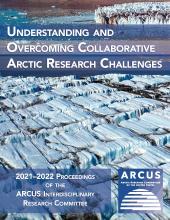
A proceedings report of the 2021-2022 ARCUS Interdisciplinary Research Committee (IRC) is now available for download. The report synthesizes the committee's discussions of Arctic interdisciplinary research collaboration as well as their efforts to both identify collaboration challenges and recommend specific actions that might be taken to increase the capacity of the wider Arctic research community to productively undertake collaborative, co-produced, and convergence research.
Call for Sea Ice Outlook Contributions

The Sea Ice Prediction Network–Phase 2 (SIPN2) Project Team announces the Call for Contributions to the 2022 Sea Ice Outlook (SIO) June Report (based on May data).
The SIO provides an open process for those interested in Arctic sea-ice to share ideas. Four monthly reports during the sea-ice retreat season will include a variety of contributions—from advanced numerical models to qualitative perspectives from citizen scientists—as well as brief related discussions. Organizers encourage all past contributors to submit Outlooks for 2022 and also hope to see new participants.
Submission Deadline: 6:00 p.m. (AKDT) Monday, 13 June 2022 (Firm)
For questions, contact Betsy Turner-Bogren (betsy [at] arcus.org)
Witness Community Highlights

The May 2022 issue of Witness Community Highlights is now available online. This issue includes three articles: Springtime at the Arctic Data Center, a summary of recently developed resources; the ARCUS Community Member Profile of Hannah Holland-Moritz, Postdoctoral Research Associate at the University of New Hampshire; and Legal and Inupiat Perspectives on Adaptations to Repetitive Flooding Events in Arctic Communities, an overview of efforts to investigate options, obstacles, and opportunities related to climate change adaptation.
For questions, or to suggest topics for future articles, please contact Betsy Turner-Bogren, ARCUS (betsy [at] arcus.org).
Arctic Research Community Survey
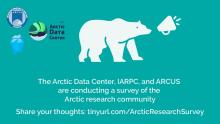
The Arctic Data Center, the Interagency Arctic Research Policy Committee (IARPC), and ARCUS are jointly conducting a survey of the Arctic research community to develop a better understanding of the networks, forums, resources, tools, workshops, and trainings that support Arctic research collaboration and data management. The survey will be open until 15 June and all individuals who engage in Arctic research activities are invited to participate. The survey should take approximately 10-15 minutes to complete. Responses will be anonymized and available to the public after collection.
Live Event with PolarTREC Teacher Erin Towns

Please join us for a PolarConnect event with teacher Erin Towns from Ilulissat, Greenland! This live event will happen on Tuesday, 10 May at 6 a.m. Alaska (7 a.m. Pacific, 8 a.m. Mountain, 9 a.m. Central, 10 a.m. Eastern). Erin is working on the Greenland Subglacial Tremor Project which will improve our understanding of how increases in surface runoff will influence ice flow and subsequent loss of water mass from the Greenland ice sheet to the oceans. You can read more about her experiences in the field on her expedition page. The event will last for one hour with a Q&A session at the end. Tell your friends, colleagues, and family. This event is free and easy to join!
Polar Technology Community Forum Meeting

The Polar Technology Community Forum will have their first self-forming team meeting on Friday, 6 May 2022, 9:00-10:00 a.m. AKDT/10:00–11:00 a.m. PDT/1:00 –2:00 p.m. EDT. This open meeting will include information about the intentions for this team, outcomes from the 2020 Polar Technology Conference, and a presentation from Mike Prior-Jones (Cardiff University) entitled, "Solar regulators: how to stop them sucking the life out of your polar instrumentation". Login information will be sent to all IARPC Polar Technology Community Forum members prior to the event. Joining the IARPC Collaborations forum is free and membership can be requested through the IARPC webpage. The meeting and team membership are open to all who are interested in Arctic and Antarctic polar technology.
Witness Community Highlights

The April 2022 issue of Witness Community Highlights is now available online. This issue includes two articles: Investigating Dramatic Growth in Thermokarst Features in Interior Alaska, an overview of how climate warming across interior Alaska has dramatically increased the top-down thaw of permafrost; and Artificial Intelligence and Machine Learning Tools for Arctic Research, a discussion of how Artificial Intelligence (AI) and Machine Learning (ML) offer strong applications to Arctic science problems.
For questions, or to suggest topics for future articles, please contact Betsy Turner-Bogren, ARCUS (betsy [at] arcus.org).
